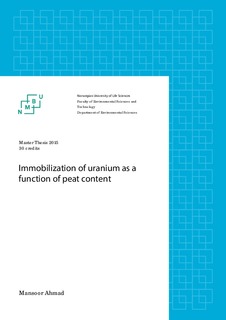| dc.description.abstract | Norwegian Public Road Administration (NPRA) has been constructing a new highway (RV 4) in Hadeland, east Norway since the autumn of 2013. Along this highway, a tunnel is also being constructed near Gran Center. Constructing this tunnel will produce huge masses of rock debris by excavation. The bedrock in Gran is described by presence of alum shale which is rich in uranium. The uranium rich alum shale will be dumped in a pit near to tunnel. By dumping this excavated alum shale, there is a high potential for mobilization of uranium and other trace metals that may contaminate the groundwater. As a precaution, it is suggested that peat should be dumped together with the excavated material due to its capacity to sorb metals. Samples of peat, pit water and alum shale used in this study were collected from the Gran site.
In this study, batch laboratory experiments were designed to investigate the properties of peat as adsorbent for uranium and other trace metals leaching out from the alum shale. The influence of adsorbent dose on adsorption process was studied. The adsorbent dose is defined as product of contact time and initial concentrations of metal ions in aqueous solution. Six doses (100, 20, 10, 4, 2 and 1) of peat were applied to adsorb uranium and other metals from pit water from Gran site and contaminated water which was prepared in laboratory by mixing pit water and alum shale. These two water samples were having different initial concentrations of uranium and other trace metals. Adsorbent and adsorbate solution were shaken with 200 rpm at shaking table at room temperature and samples were taken at interval of 1 and 24 hours and analyzed by Inductively coupled plasma-mass spectrometry (ICP-MS).No pH adjustment was made.
Results revealed that peat is an efficient adsorbent for uranium and some other trace metals leaching out from alum shale like nickel and molybdenum but not for arsenic and sulphur. In this study the most concerned metal was uranium. Adsorption percentage of uranium increased by increasing the adsorbent dose and contact time. Contact time became important factor when adsorbent dose was decreased and initial concentrations of metal ions were increased. Adsorption capacity of adsorbent increased by increasing the initial metal ion concentration and by decreasing the adsorbent dose. 10 g/L of peat proved to be high enough dose to remove worst case contamination concentration in contact time of 1 hour. By decreasing the adsorbent concentration to 4 gram/L, adsorption rate of 90 percent was achieved but it took 24 hours. By decreasing the adsorbent concentration to 2gram/L and 1 gram/L, adsorption percentage decreased. In case of higher initial concentrations of metal ions, higher adsorbent concentration was required and vice versa. Instead of removing arsenic and sulphur from solutions, they leached out from peat and their concentration increased in the solution.
Based on the results it is recommended that at 4 to 10 gram/L of peat can be used for adsorption of uranium and other trace metals (e.g) that may leak out of alum shale. | nb_NO |
